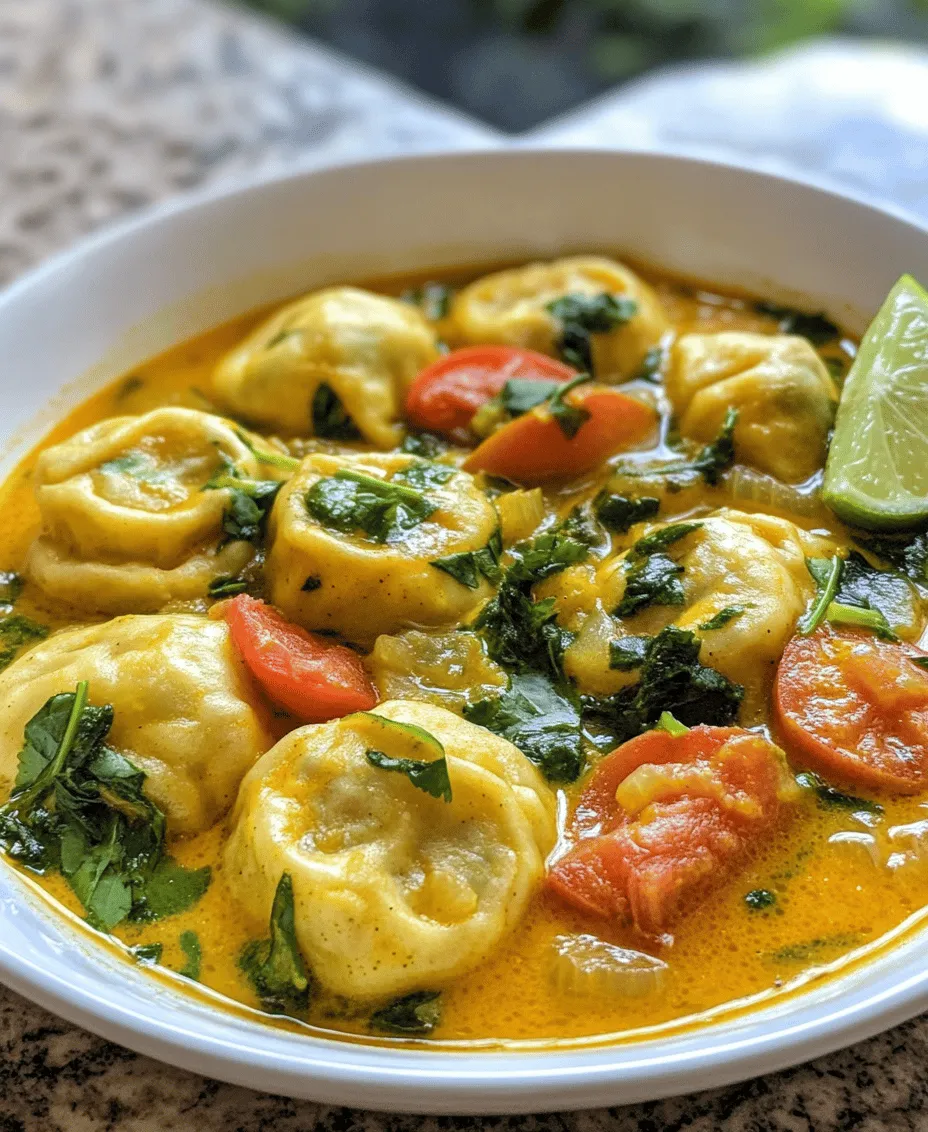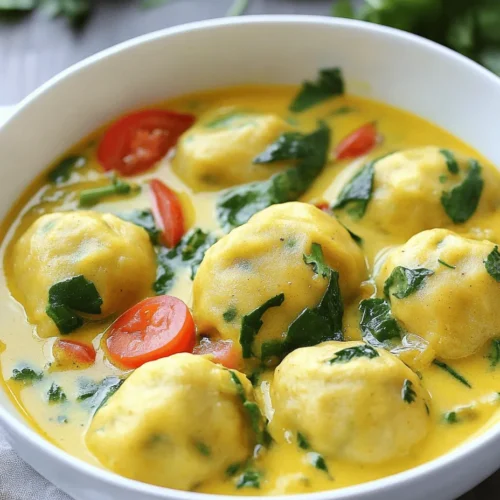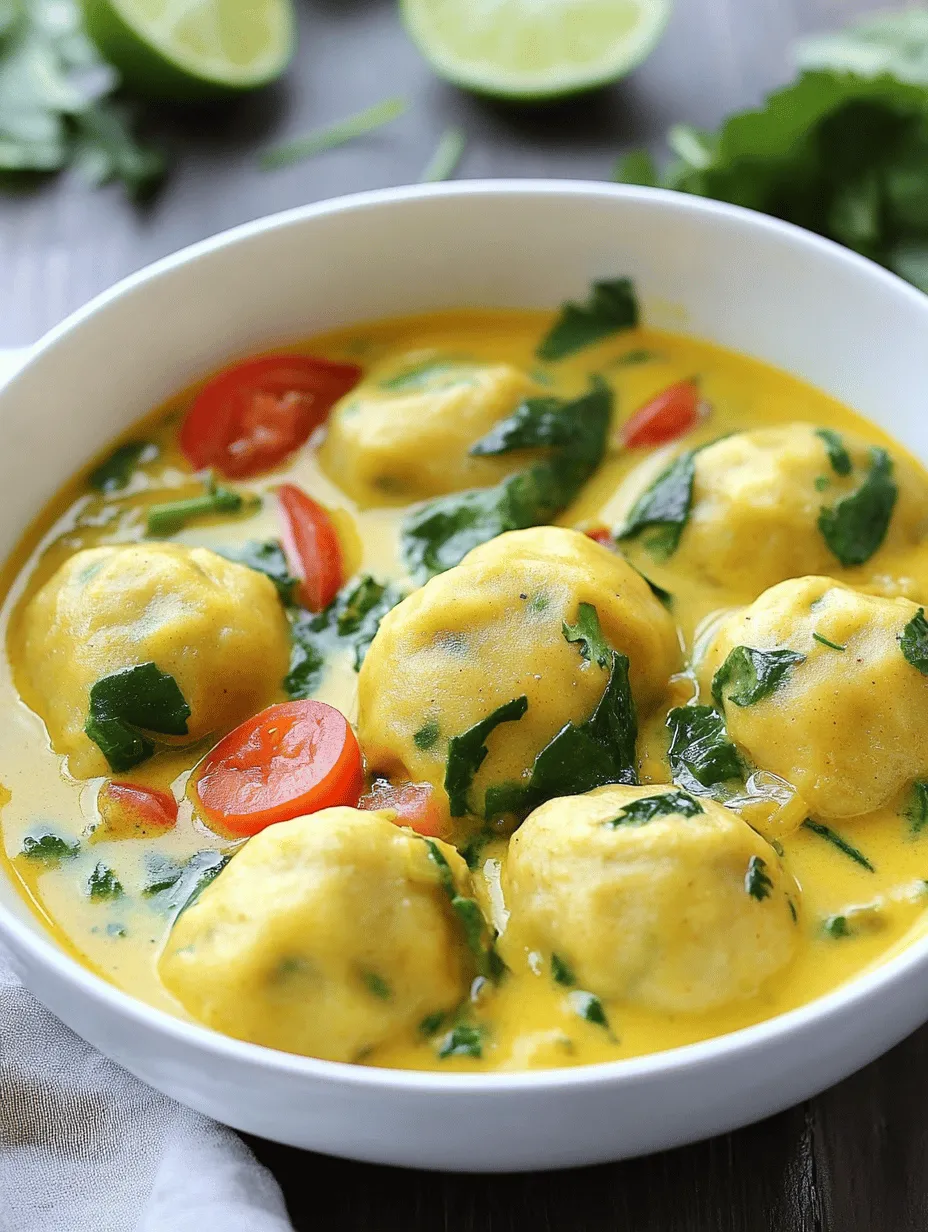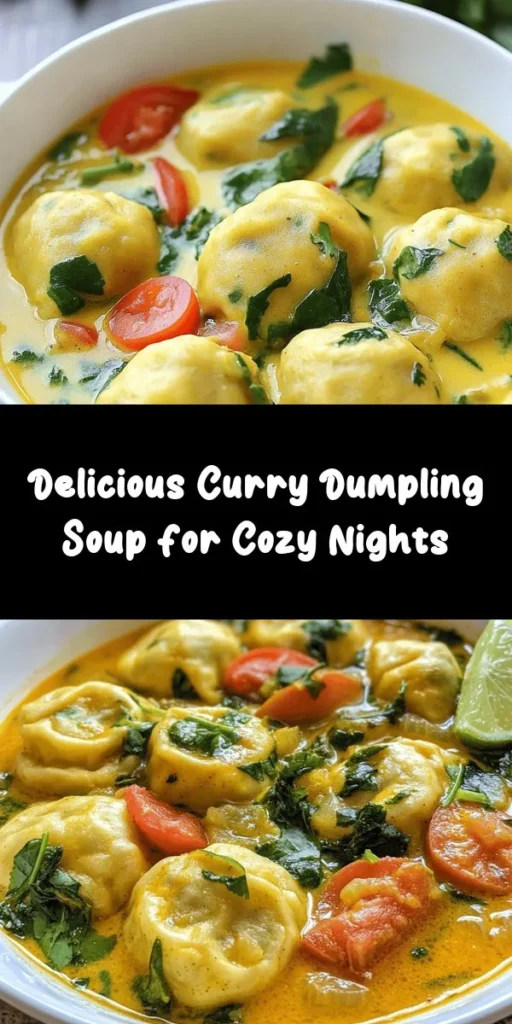Introduction
Curry dumpling soup is a delightful dish that brings warmth and comfort to the table, making it a favorite among lovers of Asian cuisine around the world. Originating from various culinary traditions, particularly in Southeast Asia, this soup harmoniously combines the rich flavors of curry with the heartiness of dumplings, creating a dish that is both satisfying and nourishing. The soup has evolved over time, with different regions infusing their unique spices and ingredients into the base recipe, making it a versatile choice for home cooks.
The significance of curry dumpling soup extends beyond just its taste; it has become a staple in many households, particularly during colder months when a warm bowl of soup can be the ultimate comfort food. The combination of soft, chewy dumplings nestled in a fragrant curry broth not only tantalizes the taste buds but also provides a host of health benefits. With the inclusion of fresh vegetables, aromatic spices, and a rich broth, this dish is as nutritious as it is delicious.
The appeal of this recipe lies in its blend of flavors and textures. The dumplings, which can be filled with an array of ingredients, provide a satisfying bite, while the soup envelops them in a creamy, spiced broth that warms the soul. Whether you are looking for a quick meal or a dish to impress guests, curry dumpling soup is sure to become a cherished recipe in your cooking repertoire.
Understanding the Ingredients
To create the best curry dumpling soup, it is essential to understand the role of each ingredient in the recipe. This dish is built on a foundation of key components, each contributing to its overall flavor and nutritional value.
Dumpling Ingredients
The dumplings are the heart of this dish, and their texture and flavor are crucial to achieving the perfect curry dumpling soup. The primary ingredient for the dumpling dough is all-purpose flour, which provides the necessary structure and chew. The gluten in the flour helps to create a dough that is stretchy and pliable, allowing it to hold the filling without breaking apart during cooking.
In addition to flour, the dumplings often include water and a pinch of salt to enhance the flavor. The balance of these ingredients is vital; too much water can make the dough sticky, while too little can result in a tough texture.
Vegetables
The filling of the dumplings can vary widely, but incorporating fresh vegetables not only enhances the flavor but also boosts the nutritional profile of the dish. Common vegetables used in dumpling fillings include:
– Cabbage: Rich in vitamins C and K, cabbage adds crunch and sweetness to the filling.
– Carrots: These provide a natural sweetness and are packed with beta-carotene, which is beneficial for eye health.
– Mushrooms: Adding umami flavor, mushrooms are also a great source of antioxidants.
– Green onions: These add a fresh, mild onion flavor that complements the other ingredients well.
Using a combination of these vegetables creates a filling that is not only flavorful but also nutritious, contributing to the overall health benefits of the curry dumpling soup.
Spices
Spices play a pivotal role in defining the flavor of curry dumpling soup. The following spices are essential for achieving the dish’s characteristic taste:
– Turmeric: Known for its vibrant yellow color, turmeric is a key ingredient in many curry dishes. It has anti-inflammatory properties and adds an earthy flavor to the broth.
– Ginger: Fresh ginger provides a spicy warmth that elevates the overall flavor profile. It is also known for its digestive benefits.
– Garlic: This aromatic not only adds depth to the soup but also offers numerous health benefits, including immune-boosting properties.
– Soy sauce: Adding a touch of umami, soy sauce enhances the savory aspect of the soup, balancing the spices and other flavors.
Soup Ingredients
The broth is just as important as the dumplings in this recipe. A well-crafted soup base enhances the entire dish, creating a comforting and flavorful experience.
– Vegetable broth: Using vegetable broth serves as a rich foundation for the curry dumpling soup. It provides depth of flavor while allowing the other ingredients to shine.
– Coconut milk: Incorporating creamy coconut milk adds richness to the broth, balancing the spices with its natural sweetness. It also contributes a silky texture that makes the soup feel indulgent.
– Yellow curry paste: The star ingredient for flavor, yellow curry paste combines various spices and herbs, providing a perfect blend of heat and aroma. Depending on your spice tolerance, you can adjust the amount used to suit your palate.
Fresh Herbs and Vegetables
Finishing the dish with fresh herbs and vegetables not only enhances the presentation but also adds a burst of flavor and nutrition. Common choices include:
– Cilantro: This herb adds a refreshing note that brightens the soup, making it even more appealing.
– Lime wedges: A squeeze of lime juice right before serving can elevate the flavors, adding a zesty kick that complements the richness of the broth.
– Chili peppers: For those who enjoy a bit of heat, adding sliced chili peppers as a garnish can provide an extra layer of flavor.
With these ingredients in hand, you’re well on your way to creating a delicious and nourishing curry dumpling soup.
Creating the Perfect Dumpling
Making the dumplings is a crucial step in this recipe, and it can be broken down into several manageable stages. Here’s a step-by-step guide to help you create the perfect dumpling dough.
Step 1: Making the Dumpling Dough
1. Combine the Ingredients: Start by measuring out the all-purpose flour and place it in a mixing bowl. Add a pinch of salt to enhance the flavor. Gradually pour in water, mixing with your hands or a wooden spoon until a shaggy dough forms.
2. Knead the Dough: Transfer the dough onto a floured surface and knead it for about 5-10 minutes. The goal is to develop the gluten, which will give the dumplings their chewy texture. Knead until the dough is smooth and elastic.
3. Rest the Dough: Once kneaded, wrap the dough in plastic wrap or cover it with a damp cloth. Allow it to rest for at least 30 minutes. This resting period is crucial as it relaxes the gluten, making the dough easier to roll out.
Step 2: Preparing the Filling
While the dough is resting, you can prepare the filling for the dumplings. This is where you can get creative with your ingredients.
1. Chop the Vegetables: Finely chop your chosen vegetables. The size should be small enough to fit comfortably inside the dumpling without breaking the dough.
2. Mix with Seasonings: In a bowl, combine the chopped vegetables with minced garlic and ginger. Add a splash of soy sauce and any other seasonings you prefer. Mix well to ensure the flavors meld together.
Step 3: Filling the Dumplings
1. Roll Out the Dough: After the dough has rested, divide it into smaller portions. Roll out each portion on a lightly floured surface until it is thin, about 1/8 inch thick. Use a round cutter or a glass to cut out circles of dough.
2. Fill the Dumplings: Place a small spoonful of filling in the center of each dough circle. Be careful not to overfill, as this can make sealing the dumplings difficult.
3. Shape and Seal: Fold the dough over the filling, creating a half-moon shape. Press the edges together firmly to seal, ensuring there are no air pockets inside. You can crimp the edges with your fingers or a fork to create a decorative seal.
Step 4: Cooking the Dumplings
Dumplings can be cooked in various ways, each offering a unique flavor and texture. Here are a few methods you can choose from:
– Boiling: Bring a pot of water to a gentle boil. Carefully add the dumplings and cook for about 5-7 minutes, or until they float to the surface. This method keeps the dumplings soft and tender.
– Steaming: Place the dumplings in a steamer basket lined with parchment paper to prevent sticking. Steam for approximately 10-12 minutes, allowing them to cook through while retaining their shape.
– Pan-frying: For a crispy texture, heat a bit of oil in a skillet. Add the dumplings and fry until the bottoms are golden brown. Then add a small amount of water to the pan and cover it to steam the dumplings until cooked through.
No matter which cooking method you choose, the result will be tender, flavorful dumplings ready to be enjoyed with your rich curry broth.
Stay tuned for the next part of this recipe, where we will delve into crafting the aromatic soup base and bringing this delicious curry dumpling soup together!

Steaming vs. Pan-Frying: Pros and Cons of Each Method
When it comes to preparing dumplings, the cooking method can significantly impact their texture and flavor. Two popular techniques are steaming and pan-frying, each with its unique advantages and disadvantages.
Steaming Dumplings
Steaming is a method that retains moisture and results in a tender, chewy texture. It allows the dumplings to cook evenly, making them ideal for delicate wrappers. Additionally, steaming is a healthier option as it requires no oil, preserving the integrity of the ingredients without added fats. However, it may not provide the crispy exterior that many dumpling lovers crave.
Pan-Frying Dumplings
On the other hand, pan-frying offers a delightful contrast of textures, producing a crispy bottom while keeping the filling juicy and flavorful. This method adds a rich depth of flavor through the Maillard reaction, which occurs when food is browned. However, pan-frying requires a careful balance of oil and heat to avoid burning, and it tends to be higher in calories due to the added fat.
Ultimately, the choice between steaming and pan-frying comes down to personal preference. For a healthier option with a soft texture, steaming is the way to go. If you crave a crunchy exterior paired with a tender interior, pan-frying is your best bet. You might even consider a hybrid approach, beginning with steaming and finishing with a quick pan-fry for that perfect blend of textures.
Crafting the Flavorful Soup
Now that we’ve discussed the dumpling preparation methods, let’s dive into crafting a rich and flavorful soup that will serve as the perfect base for our curry dumplings.
Building the Base of the Soup
A great soup starts with a robust base. For our curry dumpling soup, we’ll use a combination of vegetable or chicken broth, which provides depth and enhances the overall flavor profile. Start with about 4 cups of broth in a large pot.
Importance of Sautéing Aromatics: Onion, Garlic, and Ginger
To elevate the flavor of your soup, begin by sautéing aromatics. Heat a tablespoon of oil in your pot over medium heat. Add one diced onion and sauté until translucent, approximately 5 minutes. Follow this with 2 minced garlic cloves and a tablespoon of freshly grated ginger. Sauté these for another minute until fragrant. This step is crucial as it lays the foundation for the flavor, releasing the oils and essence of these ingredients into the broth.
How to Properly Incorporate Curry Paste for Maximum Flavor
Next, it’s time to introduce the curry paste. Choose a high-quality curry paste that suits your spice preference, whether it be red, green, or yellow. Adding about 2 tablespoons of curry paste to the sautéed aromatics will infuse the broth with rich flavors. Stir continuously for 2-3 minutes to toast the paste, enhancing its flavor and ensuring it melds beautifully with the aromatics.
Adding Vegetables to Enhance the Soup’s Heartiness
To create a wholesome curry dumpling soup, incorporate a variety of vegetables. Consider adding sliced carrots, bell peppers, and green beans for color and nutrition. Each of these vegetables will contribute different textures and flavors to the soup. Add about 1 cup of each, chopped into bite-sized pieces.
Cooking Times for Different Vegetables to Maintain Texture and Flavor
When adding vegetables, it’s essential to consider their cooking times. Carrots will take longer to soften, so add them first and let them cook for about 5 minutes before adding the bell peppers and green beans. Allow everything to simmer together for an additional 5-7 minutes until the vegetables are tender but still vibrant.
Bringing It All Together
With the soup base prepared, it’s time to bring everything together with our beloved dumplings.
Combining Dumplings with Soup: Timing and Technique
When you’re ready to add the dumplings, ensure the soup is at a gentle simmer. Carefully drop the dumplings into the pot, allowing enough space for them to float freely. Cooking times will vary depending on whether you’re using fresh or frozen dumplings. Fresh dumplings will typically need about 5-7 minutes, while frozen ones can take about 8-10 minutes. This will allow them to cook through without becoming mushy.
Adjusting Seasoning for the Perfect Balance of Flavors
Once the dumplings are cooked, taste the soup and adjust the seasoning. You may want to add soy sauce for saltiness, lime juice for acidity, or a pinch of sugar to balance flavors. Fresh herbs like cilantro or green onions can also be added at this stage to give an aromatic lift.
Presentation Tips for an Inviting Dish
For a beautiful presentation, ladle the soup into bowls, ensuring that each bowl is filled with dumplings and vegetables. Garnish with fresh cilantro, a squeeze of lime, and a sprinkle of chili flakes for added color and flavor. These finishing touches not only enhance the visual appeal but also invite your guests to enjoy the dish.
Benefits of Curry Dumpling Soup
Curry dumpling soup is not just a delicious meal; it also offers various health benefits.
Nutritional Analysis: Health Benefits of Key Ingredients
The ingredients in curry dumpling soup are packed with nutrients. For example, the vegetables provide essential vitamins and minerals, while ginger and garlic are known for their anti-inflammatory properties. The curry paste often contains spices like turmeric, which has antioxidant properties. The dumplings themselves can be made with whole grains, adding fiber to the meal. This makes the dish not only satisfying but also nourishing.
Comfort Food Aspect: How the Dish Promotes Well-Being and Warmth
There’s something inherently comforting about a warm bowl of soup, especially during colder months. The combination of spices in the curry and the warmth of the soup can uplift your mood and provide a sense of well-being. This dish serves as a reminder of home-cooked meals shared with family, evoking feelings of warmth and safety.
Versatility: How It Can Adapt to Different Dietary Preferences
One of the beauties of curry dumpling soup is its versatility. You can easily modify it to fit various dietary preferences. For a vegan option, use vegetable broth and omit any animal products in the dumplings. Gluten-free enthusiasts can substitute regular dumpling wrappers with gluten-free versions. Additionally, you can experiment with different proteins, such as chicken, tofu, or lentils, to cater to diverse tastes.
Cultural Significance
Curry dumpling soup is not just a meal; it is steeped in cultural significance across various cuisines.
Exploration of Curry Dumpling Soup in Various Cultures
Different cultures have their own versions of dumpling soup, often using local spices and ingredients. For instance, Chinese wonton soup features dumplings filled with seasoned pork, while Indian samosa soup incorporates spiced potato dumplings. Each variation tells a story of tradition and culinary heritage, showcasing how food can connect people across the globe.
Personal Anecdotes or Stories Related to the Dish
For many, curry dumpling soup evokes memories of family gatherings. Perhaps you remember your grandmother teaching you how to fold dumplings or the excitement of sharing a meal with loved ones. These personal connections make the dish even more special, turning a simple recipe into a cherished tradition.
Importance of Sharing Meals and Recipes in Cultural Traditions
Sharing meals is a vital aspect of cultural traditions worldwide. It fosters community, strengthens bonds, and preserves family heritage. Recipes are often passed down through generations, symbolizing love and care. Preparing and sharing curry dumpling soup can be a way to honor those traditions while creating new memories with friends and family.
Conclusion
In summary, curry dumpling soup is a delightful dish that combines the heartiness of dumplings with the vibrant flavors of a rich curry broth. From the careful preparation of ingredients to the thoughtful presentation, every step contributes to creating a meal that is both comforting and nourishing.
This recipe not only delights the palate but also offers numerous health benefits, making it a wonderful addition to your culinary repertoire. The versatility of the dish allows for endless variations, inviting you to explore and personalize it to your taste.
As you embark on your journey to make and share this curry dumpling soup, remember the joy it can bring to your table and the connections it fosters amongst loved ones. Embrace the opportunity to experiment with flavors and ingredients, and most importantly, enjoy the process of creating something truly special.



